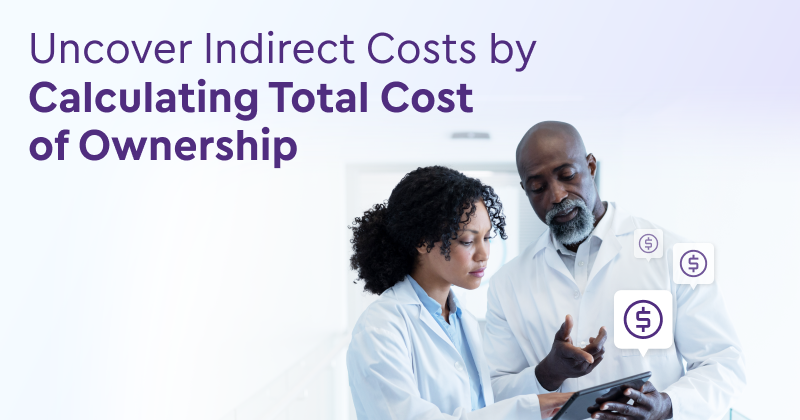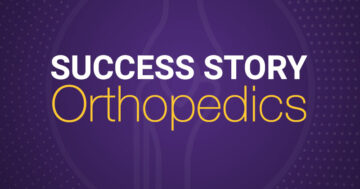Avoiding Hidden Costs: How to Calculate Your Total Cost of Ownership for Healthcare Software

A lower perceived cost might conceal expenses that could later catch your practice off guard and negatively impact your bottom line
When shopping for capital expenditures, you might think you have a handle on your practice’s finances when you’re actually not seeing the complete picture. The result? You might be spending more than you realize — and more than you need to. Instead of focusing solely on how much you spend on your EHR or practice management system, it might be better to consider a different metric entirely: total cost of ownership (TCO). TCO includes all the costs you might incur over a product’s lifetime.
By understanding and calculating your TCO, you can uncover hidden expenses and gain a true picture of your practice’s financial health, ultimately making more informed and strategic decisions.
Evaluate the total cost of ownership
When purchasing software solutions for your practice, it’s crucial to evaluate your total cost of ownership (TCO). Calculating TCO involves a comprehensive assessment of direct and indirect costs, also known as hard and soft costs. TCO helps your practice account for the ancillary expenses associated with operating, maintaining and supporting your technology over its lifetime.
Distinguish between direct and indirect costs of ownership
It’s important to distinguish between direct and indirect costs of ownership when it comes to healthcare software. Understanding these distinctions can help you allocate resources more effectively, manage budgets and make informed decisions that account for long-term goals.
Direct costs might encompass tangible expenses such as equipment, installation costs and infrastructure upgrades. Indirect costs, on the other hand, might include more variable ones, such as software subscription fees, maintenance contracts and staff training. Although indirect costs may not be immediately apparent, planning for them is essential for the overall success and sustainability of your practice.
Consider a dermatology practice purchasing laser hair removal equipment, such as diode, Nd or alexandrite lasers. Beyond the immediate costs of the equipment, that practice should budget for indirect costs, which can be substantial. One-time indirect costs might include potential facility upgrades to accommodate the machine. Ongoing indirect expenses to consider include increased utility bills due to the machine’s energy consumption, higher insurance premiums, and recurring maintenance and calibration fees. These indirect costs contribute to your TCO and must be considered when making the investment.
Similarly, choosing healthcare software components based on lower sticker prices might seem appealing to a budget-conscious medical practice. However, as shown in our dermatology practice example, it’s worth taking a step back to consider your needs holistically since a low-price solution might not account for your TCO.
Calculate TCO for your healthcare software effectively
“Pull all your software-related invoices, from patient engagement tools to IT support needs to product updates,” says Sharareh Brescia, Vice President of Sales at ModMed®. “You’ll quickly see how hidden costs add up when you’re purchasing software solutions individually and how important it is to compare apples to apples, functionality to functionality.”
Invoices to include in your calculation
- EHR
- Practice management system
- Clearinghouse services
- Patient engagement tools
- Implementing bridges between disparate systems
As you evaluate your TCO for healthcare software, keep an eye out for à la carte pricing for ancillary features, like dictation software, whose costs can quickly add up. Not accounting for these must-haves could potentially blow your budget, leaving you with a laser hair removal machine that you can’t afford to maintain or run.
Avoid risks of piecing together disparate software systems
“Using a comprehensive software solution is about more than cost control. Consider the value of not having to monitor multiple vendors’ bills month to month or avoiding workflow interruptions created by incompatible systems,” says Brescia, who has 20 years of experience in software as a service (SaaS).
Imagine a busy doctor’s practice where the staff is constantly juggling multiple software systems. Each time a patient checks in, the front desk has to enter their information into the practice management system and then re-enter it into the EHR. Later, the billing department has to pull data from both systems to process claims. This piecemeal approach can lead to frequent disruptions, errors and inefficiencies. Opting for a complete ecosystem of software can help streamline operations, reduce errors and allow the practice to run more smoothly.
Do any of these scenarios seem familiar?
- Your staff can’t access office visits and procedure notes without switching between systems.
- Your staff is getting burned out from typing the same data into your EHR and again into your practice management system.
- Your EHR system requires customizations or bridges to interface with other critical applications, like billing and analytics.
If these interruptions don’t seem familiar, consider asking your staff about similar time-consuming workarounds you may not be aware of.
Consider compliance and privacy in TCO calculations
When assessing your TCO, it’s also essential to consider regulatory requirements, like continuously changing ICD-10 codes. If your vendor is slow to update data or upgrade software, you could face compliance violations and legal consequences.
Another important consideration is how your vendor handles cybersecurity. A vendor who doesn’t take the appropriate cybersecurity measures could leave your practice vulnerable to threats such as data breaches, malware attacks or ransomware, which can result in significant financial losses. The average cost of a data breach in the healthcare sector now tops $10.93 million, nearly double what a similar breach might cost in the financial industry, and that doesn’t include the downtime and harm to patient data and trust.
Prioritize patient engagement solutions
A lack of patient engagement solutions can also have serious consequences. “Some practices may think they just need an EHR to document and a practice management system to generate claims and bills,” notes Brescia. “But prioritizing patient engagement and communication solutions is equally crucial.”
Does your vendor offer options, like a patient portal or mobile check-in, that seamlessly integrate with your other solutions? You can’t afford to lose time, money and, worst of all, potential patients due to dysfunctional software.
Patients who feel undervalued or dissatisfied with their interactions are unlikely to recommend your practice to others or return for future care. In a healthcare landscape that is rapidly digitizing, practices that fail to keep up with advancements may lose their competitive edge. Patients and referring physicians may prefer providers with modern, efficient systems that offer better experiences.
Invest wisely for long-term practice success
While opting for à la carte software components may initially seem cost-efficient, it’s essential to consider the broader picture. Hidden costs and integration challenges can quickly impact your practice’s bottom line.
Do your due diligence. Identify direct and indirect costs, and align software functionality with your long-term practice objectives. Just as savvy consumers might consult online forums to compare reviews of a new washer and dryer, considering the solutions your peers are using and their experiences is also highly recommended.
Each dollar invested in your software should yield optimal value. The goal isn’t merely to cut costs but to invest wisely to foster growth or efficiently sustain a well-oiled machine. Carefully consider direct and indirect costs and your TCO to avoid unpleasant surprises. Understanding the true costs and benefits allows you to make a more informed decision that aligns with your practice’s long-term goals and objectives.
*Benson M. “Electronic Health Record Work Demands for Gastroenterology and Hepatology Providers: A Prospective Use Analysis and Survey Study.” Dig Dis Sci 68, 1218–1225 (2023). DOI:10.1007/s10620-022-07691-6.
This blog is intended for informational purposes only and does not constitute legal or medical advice. Please consult with your legal counsel and other qualified advisors to ensure compliance with applicable laws, regulations and standards.


